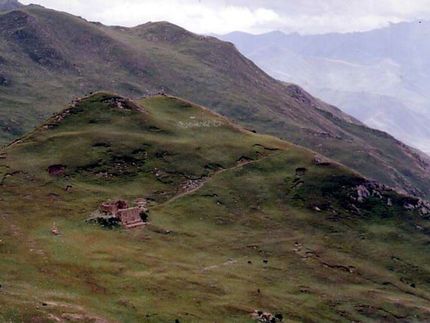These interesting traditions are proof that when it comes to the great beyond, there’s more than one way to bid farewell to the dead. Here are six fascinating funeral and burial rites from around the world.
1. Beaded, Not Buried
South Korea is running out of space for graves, and in 2000 a law was passed to combat the shortage. The law required those burying their dead to remove the grave after 60 years, kicking off a new tradition: turning dead bodies into beads. After cremation, instead of keeping ashes in an urn, remains are turned into gem-like stones and kept in glass containers. The practice has taken off, and only about 30 percent of the deceased were buried as of 2012, compared to 60 percent in 2002.
2. The After-Party

In parts of Madagascar, there’s no such thing as a final goodbye. A tradition called Famadihana, practiced by the Malagasy people, calls for the living to bring out the remains of their loved ones’ bodies for a joyous party. They dance and celebrate with the deceased for a few hours or days before returning the body back to the family crypt. Millions practice the ritual, which usually occurs every five to seven years.
3. A Lavish Affair

In Tana Toraja in eastern Indonesia, the celebration starts at the funeral, but it doesn’t end there. Families of the deceased can sometimes spend years saving up for the extravagant event, at which point attendance is in the thousands. The body spends this waiting period wrapped in cloth under the tongkonan, the ancestral home (above). Moreover, every August, families exhume their dead, dress them in new clothing, and parade them around the village, in a ritual known as Ma’Nene.
4. Guess Who's Coming to Dinner
Anthropologists call it endocannibalism: and yes, the cannibalism part is precisely what it sounds like. The ritual, which was once practiced by the Melanesians of Papua, New Guinea and the Wari people of Brazil, among others, consists of eating the ashes or ground-up bones of deceased tribe members. It was seen as a way to express respect, connect the living to the dead, or allow the spirits of the dead to live on within the bodies of the tribe. For the Yanomami people of South America, the practice served a second purpose: they believed that if the ashes of the dead weren’t consumed, the soul would become an evil spirit that would harm members of the community.
Related: The Curious Histories Behind 4 Dead or Dying Languages
5. Sky High

What happens when you die? Some Vajrayana Buddhists in Mongolia and Tibet believe that upon death the soul sheds itself of the body, leaving behind an empty vessel husk. The body is returned to the earth by being left upon the mountaintop, exposed to the elements and carrion animals such as vultures. The ritual has been performed for thousands of years, and many Tibetans still choose a sky burial to this day.
6. Custom Coffins

In Ghana, it’s popular to go out in style, choosing what’s known as a “fantasy” coffin. These colorful, custom-made coffins are carved and decorated so as to represent something special about the dead, like a hobby or occupation. The body of a fisherman may be laid to rest in a coffin shaped like fish; the body of a mother may be buried in a casket that looks like a giant hen; a farmer's remains may end up inside of a coffin styled into a large ear of corn.
Featured photo: Ania Blazejewska / Getty Images
